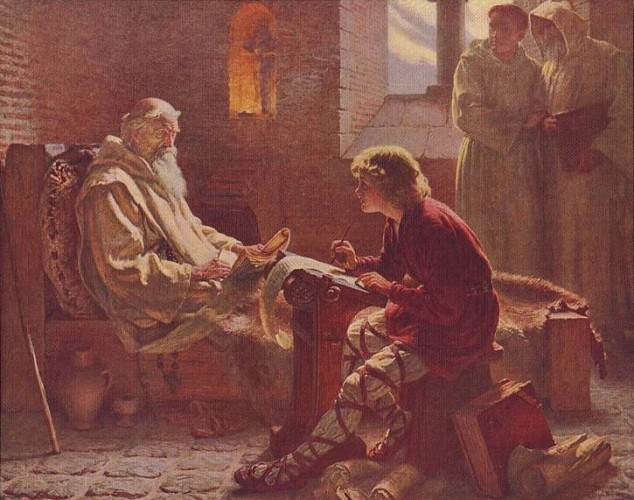Bede’s Temple as History
Conor O’Brien (Sheffield)
Another IHR paper, this time, a talk given about Bede’s writing and his interest in the image of the Temple and its relation to Christianity. This paper also examined how Bede’s views shifted over time. How did Bede view Judaism? Was he truly ambivalent?
In general, Bede believed history had taken its toll on the temple. The destruction of the temple marked the end of the period where it was acceptable for Christians to practice their Jewish religion. Bede inherited the Augustinian tradition. This influence of Augustinian ideas allowed Bede to emphasize continuity in religious practice between the Old Testament and the New Testament. Progress before Christ could be put into the pre-incarnation history of six ages of the world in the Patrician tradition. Progress took place before and after Christ and the temple represented one stage in the Church’s eschatological development. Bede only understood history in its eschatological purpose. He rendered the abandonment of the Temple cult as less negative and his views on Judaism changed over time. Bede had a more positive view of Jews in the latter part of his career. What changed in his writing was the degree in which he emphasized the break between the two religions:
’Therefore divine dispensation correctly brought it about that both that city and the temple and all those things were to be destroyed together lest by chance anyone immature in faith (if he had seen those things remain) might be swept away, astounded by that vision of the diverse appearances during the ceremony of the sacrifices, during the succession of the services’
In Lucam, ed. Hurst, CCSL 120, p.364, trans. Conor O’Brien [710×715]
By the 720s, Bede discarded his ambivalence and his writings continued to talk about the decline and fall of the Jewish temple and the rejection of the temple by the Lord. His earlier writings show a particular contempt for the riches and trappings found in the temple. He contrasted the temple to Cuthbert’s Anglo Saxon hermitage. In his later writing, Bede suddenly drops this comparison. In his later work, Bede was more interested in the parallels in the Jewish religion and Christianity versus their differences and the perceived victory of Christianty over Judaism.
Another important issue that factored into Bede’s writing was the Easter Controversy. In 716, the monks of Iona finally accepted Roman Easter. The Easter Controversy was used as a symbol the conversion to Christianity from Judaism and the winning of Roman Orthodoxy over the incorrect Easter dating. The change in Iona created a new situation for the Northumbrian church. Bede’s understanding of the temple cult helped him understand Northumbrian ecclesiastical affairs. His church, Monkwearmouth-Jarrow, was part of the campaign to bring Iona in line with the Roman Easter celebration.
He primarily used the temple’s significance to parallel events in his own time. Christian spiritual exegesis often relied on history to prove its validity. The temple image symbolised Christ and his work. Bede, however, looked beyond the life of Christ for figures in the temple image. Bede believed one could see their own lives in the reflection of the Bible; and not in one definable event but in an ongoing process. For Bede, Anglo Saxon history wasn’t the fulfilment of Christian scriptural prophecy but an ongoing fulfillment that would continue on into the future. He emphasised that non-Christians didn’t understand the idea of universal history.
[Bede’s allegorical commentary on the temple] ‘which attentively reading, then the more you find the mysteries of Christ and the Church contained in the ancient pages and the more liberally you see the gifts of God bestowed upon us in this present time or promised us in the future, the more tolerable and less worthy of concern will you consider the favourable and unfavourable vicissitudes of perishable things…’
De templo, ed. Hurst, CCSL 1191, p.144; trans. adapted from Connolly (1995), p.3














Pentru a putea adăuga comentarii trebuie să fii membru al altmarius !
Alătură-te reţelei altmarius